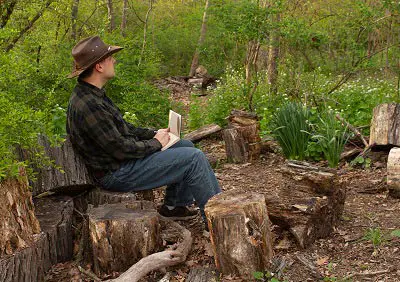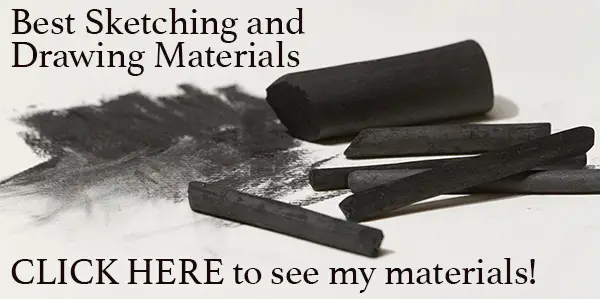
Sketchbook Ideas: 10 Great Ideas To Maintain Your Artistic Inspiration
Whether you just started or have been sketching for some time, it can be challenging for artists to keep up their sketchbooks. Here are some sketchbook ideas: 10 great ideas to maintain your artistic inspiration so you never run out of ideas on what to sketch.
Change Your Sketching Environment
Getting into a different environment can reawaken your enthusiasm for sketching. If you are tired of doing still lifes, go outside and try drawing some trees, clouds, or even animals. Sketching can be combined with bird watching or even fishing, especially when the fish aren't biting.
If you primarily do country sketching, take a drive in town and challenge yourself with some intense perspective, geometric shapes, or crowds of people.

Try Roadside Sketching
This somewhat ties into the previous suggestion, but one of my favorite pastimes is taking long country drives and looking for things to sketch. It’s a nice way to relax and internalize the beautiful discoveries you have made. It doesn’t always have to be someplace new. Light is always changing and changing how things look. There may now be an animal on that same country road you always travel. Or you can finally go down that one road you have always wondered about.
For your safety, I recommend doing this on quiet country roads, preferably dirt roads, or if you are sketching in the city, find a safe place to park and either sit in your car or bring a small fold-up chair. Don't park along busy roads with little or no shoulder as this can be dangerous.
If you are going to park by somebody’s house, you may want to knock on their door and introduce yourself with a business card and an explanation of what you are doing so as not to raise any alarm. I’ve found that most people are very welcoming and will even want to see your sketches when they are done. I’ve even been brought cookies and hot chocolate by friendly residents while sketching out in the cold.
Get A Different Kind Of Sketchbook
If your current sketchbook has a cheap, uninspiring feel, you may get inspiration from a good quality sketchbook. If your sketchbook is really nice and you are afraid to sketch in it, do the opposite and buy a cheap one so you won’t be afraid of making mistakes on good paper.
Insider Tip: There is a wide variety of sketch pads and sketch journals available on the market. Rough paper works well for watercolors, pastels, and heavily textured drawings; smooth paper works create for pencil, ink, and drybrush watercolor techniques. You can try toned paper such as tan, gray, blue, and even black, which can be used with white charcoal.




Try Sketching With A New Medium
A new medium can open a world of possibilities. If you have been sketching in pencil, try charcoal or pen and ink. You can also dive into watercolor, though this may require a different type of sketchbook. And you can go all out and begin oil painting outside, though this requires a lot more equipment.
I started sketching in pencil, then a couple of years later I sketched in a ball-point pen to force myself to work without an eraser. After that, I did watercolor and kept that going for years. My first watercolor sketchbooks were atrocious, but eventually, I got better. The goal is to experiment until you find something you really connect with.
Don’t judge yourself by your first attempts at a new medium. If you enjoy it, continue to use it.
Practice Contour And Gesture Exercises
Contour and gesture exercises will sharpen your skills of observation and are a great way to learn how to draw.
Contour drawing is where you don’t look at your paper as you try to draw the outline and surface of your subject without removing your pencil from the paper. Yes, there are times when the pencil will run off the paper, and results may look like you just got back to your dorm room from a college kegger, but you are not doing this for results, it’s an exercise in observation.
Gesture drawing is when you try to capture the overall shape and feel of the entire object by moving your pencil over the paper in a very loose and rapid fashion using the full motion of your arm. The results will be a bunch of scribbles, but you should not pause to erase or make corrections. The goal is to capture the essence and movement of the form.
Gesture drawing is a time-honored method utilized by master artists such as Rembrandt, Michelangelo, Degas, and others.
The two above methods were the primary means I learned to draw when I first stated. Kimon Nicoladies book, The Natural Way to Draw is a great resource for learning these methods. See my review of this classic book.




Try A New Sketching Technique
There are as many styles of sketching and drawing as there are people doing it. But experimenting with a new approach or style may be just what you need. If you tend to sketch with outlines, try eliminating them and sketch just the light and shadow shapes of the subject using a shading technique, or vice versa. I go into further detail on this approach in the article Drawing Without Boundaries.
You can also try holding your pencil differently. Rather than holding it as if you were writing, try holding it as if you were picking it up and drawing more with the side of the tip. Another method that works well with charcoal is to rub some broad strokes of vine charcoal on paper then draw out the lighter areas with a kneaded eraser.




Go On A Sketching Vacation
We all can become too familiar with our surroundings. If this has happened to you, and you have the means, take a trip somewhere and bring along your sketch gear. It doesn’t have to be to Europe, it can just be a weekend trip to a different part of your state, a camping trip or a visit to a state or national park.
Insider Tip: One trick I use for finding interesting places to sketch is by using Google Maps to search the surrounding area for photos of parks or recreational areas. If you scroll over the name of a park, a hyperlink may appear. Click on that link and you may get a photo that appears in the upper left corner. Clicking on that photo usually brings up multiple photos that you can scroll through. See below.




Go Sketching With a Group
The life of an artist can be a lonely business, so call up another friend and ask them to go sketching. They don’t necessarily have to be an artist. Perhaps it can be a neighbor or family member that you can share your sketches with. You may even inspire them to start their own sketchbook.
While most of my sketching these days is a solo affair, I have fond memories of the plein air painting events I used to do. It was great looking over the shoulders of other artists and talking shop with them later in the cafe. We would also share painting locations with each other… most of the time.
See the types of pencils, charcoal, and paper I use on the Drawing and Sketching Resources Page.
Practice Meditative Sketching
The act of sketching can be very relaxing but sometimes you can get too analytical. A great way to regenerate your inspiration is to use sketching as a form of meditation. This is described briefly in Clare Walker Leslie's classic, The Art of Field Sketching. Click here to see my review of this great book.
To do this, go outside with your sketchpad to a peaceful place that has no distractions. Sit quietly, breathe deeply, listen, and let go, becoming fully aware of your surroundings. When you notice something, sketch it, focusing more on the subject than the paper. The goal is not the resulting sketch, but to get to know your subject in a deeply intimate way.
Get Inspired By Other Artist's Work
So many artists, both visual and musical can trace their desire to create back to seeing or hearing another artist's work. We stand on the shoulders of others. If you're in a slump, make a visit to a museum or art gallery. If this is not possible, there is an infinite amount of inspiration on websites like Pinterest where you can just type the term sketches or pencil drawings and spend hours looking at different work.
Jason Tako is a nationally known fine artist who specializes in western, wildlife, plein air, and Historical Native American subject matter. He spent his learning years sketching the wetlands and wooded areas of rural Minnesota. He has been featured in Plein Air Magazine and Western Art Collector Magazine and he was the Featured Artist for the 2020 Southeastern Wildlife Expo. See his work at www.JasonTako.com and his demonstrations on his YouTube Channel.
Warning: Undefined array key "preview" in /home3/mysketc2/public_html/wp-content/plugins/oxygen/component-framework/components/classes/comment-form.class.php on line 75


Warning: Undefined array key "preview" in /home3/mysketc2/public_html/wp-content/plugins/oxygen/component-framework/components/classes/comment-form.class.php on line 79